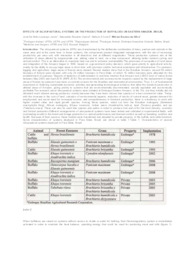Effects of silvopastoral systems on the production of buffaloes on Eastern Amazon, Brazil.
Effects of silvopastoral systems on the production of buffaloes on Eastern Amazon, Brazil.
Summary: The silvopastoral systems (SPS) are characterized by the deliberate combination of trees, pasture and animals in the same area and at the same time. In these systems, the components present integrated management, with the aim of increasing productivity per area unit, with interaction in all directions and at different magnitudes. These production systems aim at the utilization of areas altered by inappropriate use, adding value to land, via a tree component, allowing better nutrient cycling and animal comfort. This is an alternative to maximize land use and to enhance sustainability.The processes of occupation of rural areas and integration of the Amazon began in 1960, based on a government policy decision, which gave priority to agricultural activity, mainly by the ability to occupy large areas in short time, with provision credits, technical assistance and infrastructure. For pastures, logging and agriculture, large areas of forests were cleared. Recent studies show that in the Brazilian Amazon, around 58 mil lion hectares of forests were cleared, with only 29 million hectares in Para State, of which 15 million hectares were allocated for the establishment of pastures.
Publication year: 2010
Types of publication: Paper in annals and proceedings
Unit: Embrapa Eastern Amazon
Observation
Some of Embrapa's publications are published as ePub files. To read them, use or download one of the following free software options to your computer or mobile device. Android: Google Play Books; IOS: iBooks; Windows and Linux: Calibre.
Access other publications
Access the Agricultural Research Database (BDPA) to consult Embrapa's full library collection and records.
Visit Embrapa Bookstore to purchase books and other publications sold by Embrapa.

